Types of Social Login Providers
Turnkey supports two different types of Social Login Providers:- OIDC Providers (Google, Apple, Auth0, Cognito…) These providers issue your app an OIDC ID Token identifying an end-user, which can subsequently be passed to Turnkey as a means of authentication.
- OAuth 2.0-Only Providers
(X/Twitter, Discord…)
These providers do not issue OIDC ID Tokens themselves, and instead provide only bare-bones OAuth 2.0. To work around this limitation, Turnkey runs the OAuth 2.0 Authorization Code + PKCE flow, calls the provider’s
who-am-Iendpoint using your app’s credentials, and then uses the returned user data to issue a short-lived OIDC ID token. In effect, Turnkey acts as an “OIDC Wrapper” for these OAuth 2.0 Services.
Social Login Provider Types - Comparison
The table below can be helpful in understanding the similarities and differences between the two types of Social Login Providers that Turnkey supports:| Provider Type | OIDC Provider | OAuth 2.0-Only Providers |
|---|---|---|
| Providers | Google, Apple, Facebook, Auth0, Cognito | X/Twitter, Discord |
| Token Transport | Returned to your App by Provider | Returned by Turnkey after the OAuth 2.0 Auth Code + PKCE flow |
Issuer (iss) | Provider (iss = Provider URL) | Turnkey (iss = Turnkey URL) |
Audience (aud) | Provider’s client_id for your app | Provider’s client_id for your app |
Subject (sub) | Provider’s subject (stable user ID) | Derived from ID who-am-I response (e.g., x:123456789) |
Nonce (nonce) | Sent to Provider; echoed in ID token | Sent to Turnkey; echoed in ID token. |
| Refresh/access | If the Provider returns them, you may use them | Not provided. |
Roles and responsibilities
- Turnkey: Runs verifiable infrastructure to create credentials, verify OIDC tokens and, in the case of OAuth 2.0-Only Providers, issue them as well.
- Parent: That’s you! For the rest of this guide we’ll assume you, the reader, are a Turnkey customer. We assume that you have:
- An existing Turnkey organization (we’ll refer to this organization as “the parent organization”)
- A web application frontend (we’ll refer to this as just “app” or “web app”)
- A backend able to sign and POST Turnkey activities (“backend” or “parent backend”)
- End-User: The end-user is a user of your web app. They have an account with Google.
- OIDC Provider: A provider able to authenticate your End-Users and provide OIDC tokens as proof. We’ll use Google as an example.
- OAuth 2.0-Only Provider: A provider of OAuth 2.0-based Authorization, for which Turnkey is able to act as an “OIDC Wrapper”.
Authentication Sequence Diagrams
The sequence diagrams below display the differing flows for the two types of Social Login Providers.OIDC Provider
Create API Key
Start the OAuth Login Flow
Initiate OAuth with Nonce
nonce to sha256(publicKey) based on the API public key. This binds the resulting OIDC token to the keypair.User Grants Permission
oidcToken to the frontend.Send Credentials to Backend
oidcToken and API public key to your backend.Get or Create a Turnkey Sub-organization
oidcToken. If no sub-organization exists, it creates one using the identity in the token.Create a Session
oauth_login with the oidcToken, and API public key. Turnkey validates that the token’s nonce matches sha256(publicKey) and returns a session JWT. The backend sends this JWT to the frontend.You're Now Authenticated
x-stamp header.OAuth 2.0-Only Provider
Create API Key
Start the OAuth Login Flow
Initiate OAuth
User Grants Permission
oidcToken to the frontend.Provider Delivers auth_code
Get OIDC Token
OAuth2Authenticate activity.Get or Create a Turnkey Sub-organization
oidcToken. If no sub-organization exists, it creates one using the identity in the token.Create a Session
oauth_login with the oidcToken, and API public key. The backend sends this JWT to the frontend. NOTE: For this flow, the nonce is not required to match sha256(publicKey).You're Now Authenticated
x-stamp header.What does Turnkey use from the OIDC tokens to prove identity?
Turnkey parses and validates the following fields from the OIDC token to confirm the user’s identity:issuer(iss) – The OAuth provider that issued the token (e.g.,https://accounts.google.com)audience(aud) – The OAuth app’s client IDsubject(sub) – The unique identifier for the user in the OAuth provider’s system
Some OAuth providers (like Google) encourage you to register separate client IDs for each platform (e.g., web, iOS, Android). However, as discussed above, in the Turnkey flow the
aud claim from the OIDC token is used as part of how sub-organizations are identified.
If a user logs in on one platform using the web client ID, and then later logs in on another platform using a different iOS client ID, the two tokens will have different aud values. Because of this, Turnkey will not consider them the same identity.
To ensure users are recognized consistently across platforms, you must use the same OAuth client ID everywhere. In most cases, this means using your web client ID for web, iOS, and Android flows.
OIDC token verification
All OIDC tokens are verified inside of Turnkey’s secure enclaves. We’ve designed a new secure enclave to fetch TLS content securely and bring non-repudiation on top of TLS content: our TLS fetcher returns a URL and the fetched content, signed by the TLS fetcher’s quorum key. By trusting the TLS fetcher quorum key, other Turnkey enclaves can bring TLS-fetched data into their computation safely. Verifying OIDC token is the first computation which requires this! To verify an OIDC token, other Turnkey enclaves receive the OIDC token as well as:- the signed content of the issuer’s OpenId configuration. OpenId configuration must be hosted under
/.well-known/openid-configurationfor each domain. For Google for example, the issuer configuration is ataccounts.google.com/.well-known/openid-configuration. This JSON document contains, among other thing, ajwksUrikey. The value for this key is a URL hosting the list of currently-valid OIDC token signers. - the signed content of the issuer’s
jwksUri(e.g., for Google, thejwksUriisgoogleapis.com/oauth2/v3/cert). This is a list of public keys against which the secure enclave can verify tokens. Note: these public keys rotate periodically (every ~6hrs), hence it’s not possible to hardcode these public keys in our secure enclave code directly. We have to fetch them dynamically!
iss, aud and sub attributes against the registered OAuth providers on the Turnkey sub-organization. We also check exp to make sure the OIDC token is not expired, and the nonce attribute (see next section).
Nonce restrictions in OIDC tokens
OurOAUTH_LOGIN activity requires 2 parameters minimum:
oidcToken: the base64 OIDC tokenpublicKey: the client-side public key generated by the user
nonce claim is set to sha256(publicKey).
For example, if the public key is 0394e549c71fa99dd5cf752fba623090be314949b74e4cdf7ca72031dd638e281a, our enclaves expect the OIDC token nonce to be 1663bba492a323085b13895634a3618792c4ec6896f3c34ef3c26396df22ef82.
This restriction only applies during authentication (OAUTH activity). Registration via CREATE_OAUTH_PROVIDER and CREATE_SUB_ORGANIZATION activities is not affected since these activities do not accept a publicKey and do not return encrypted credentials as a result.
If your OAuth provider does not allow you to customize nonce claims, Turnkey also accepts and validates tknonce claims. This is an alternative claim that will be considered. Only one of (nonce, tknonce) needs to be set to sha256(publicKey); not both.
OAuth vs. OIDC
OAuth2.0 is a separate protocol from OIDC, with distinct goals:- “OAuth2.0” is an authorization framework
- “OIDC” is an authentication framework
OIDC Providers
Below, some details and pointers about specific providers we’ve worked with before. If yours isn’t listed below it does not mean it can’t be supported: any OIDC provider should work with Turnkey’s OAuth.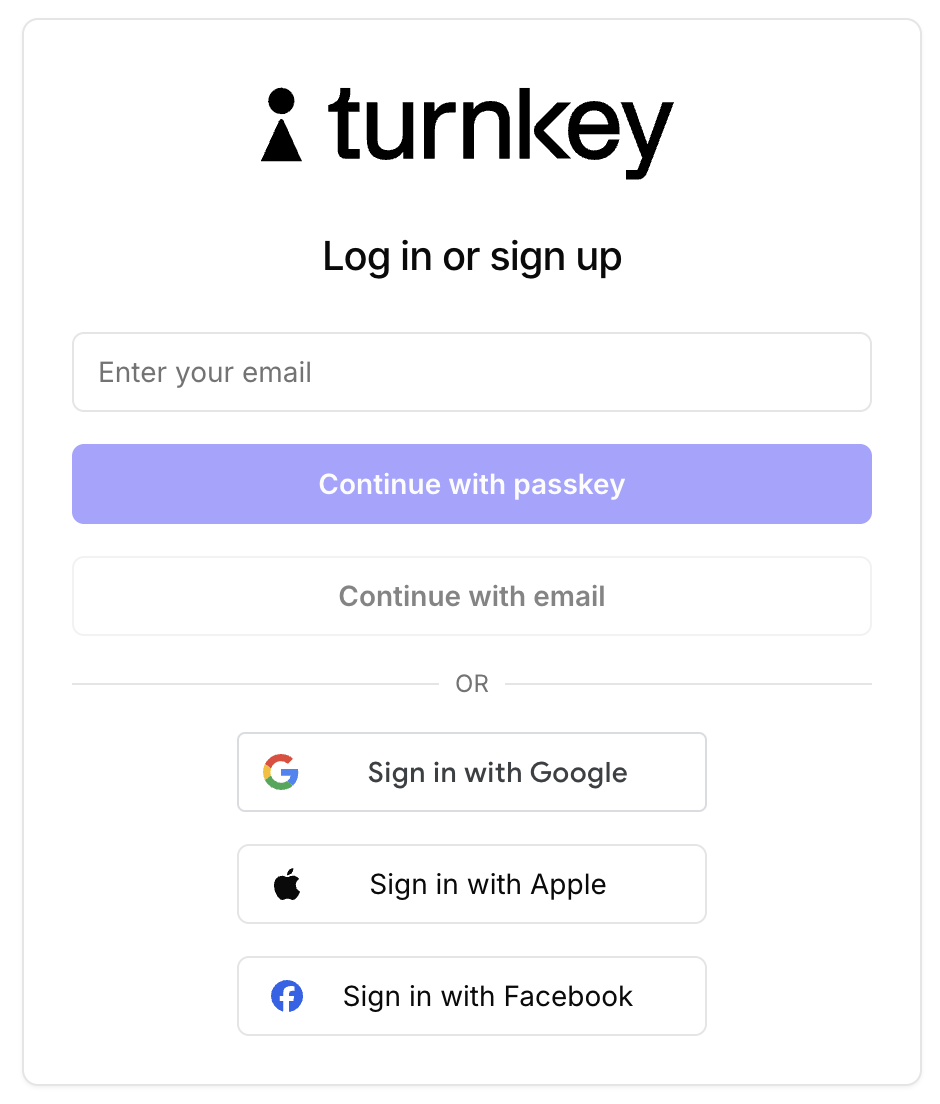
Apple
Apple integration is also extensively tested and supported, and is integrated into our demo wallet (hosted at https://wallet.tx.xyz). The code provides an example component as well as an example redirect handler. Documentation for Apple OIDC can be found here.- You will need to generate a code verifier that can either be recalled (e.g. from a database) or reassembled in a later request.
- You will need to provide a code challenge as a parameter of the OAuth redirect that is either the code verifier itself or the hash of the code verifier.
- Instead of receiving the OIDC token after the OAuth flow, you will receive an auth code that must be exchanged for an OIDC token in a subsequent request. The code verifier and your app’s ID are also required in this exchange.
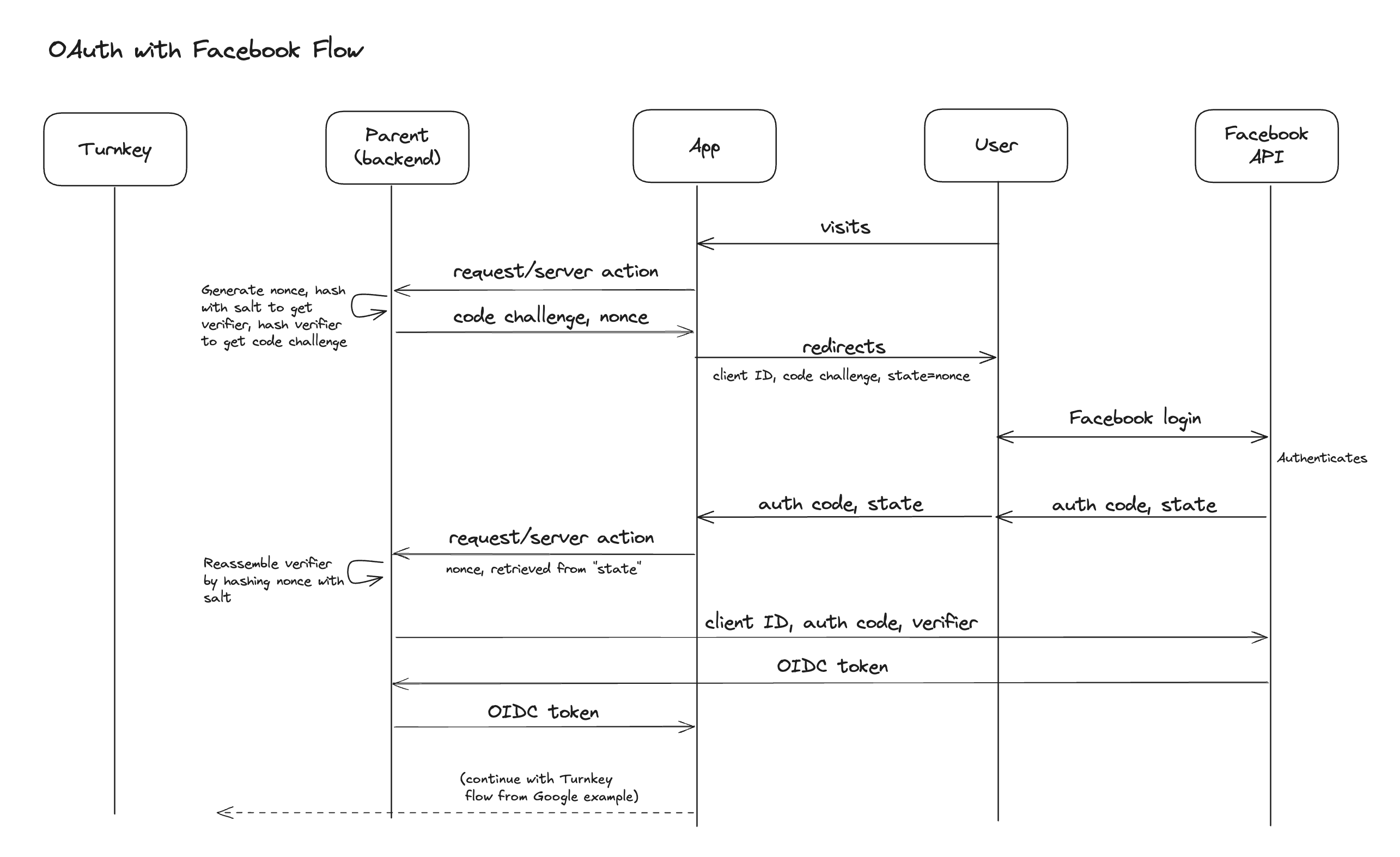
Auth0
This provider was tested successfully and offers a wide range of authentication factors and integration. For example, Auth0 can wrap Twitter’s auth or any other “Social Connection”. In the testing process we discovered that Auth0 admins can manage users freely. Be careful about who can and can’t access your Auth0 account: Auth0’s management APIs allow for account merging. Specifically, anyone with ausers:update scope token can call this endpoint to arbitrarily link an identity.
For example, if a Google-authenticated user (OIDC token sub claim: google-oauth2|118121659617646047510) gets merged into a Twitter-authenticated user (OIDC token sub claim: twitter|47169608), the OIDC token obtained by logging in through Google post-merge will be twitter|47169608. This can be surprising and lead to account takeover if an Auth0 admin is malicious. This is documented in Auth0’s own docs, here.
AWS Cognito
The main thing to call out is the inability to pass customnonce claims easily. To pass the hash of the end-user’s public key, use a custom tknonce claim instead.
Social linking
Social linking is the concept of automatically linking an email address to a Turnkey user by authenticating with a social provider. This allows an end-user to authenticate with the social provider, or a matching email address. Currently, we only allow automatic linking for Google social logins. The cases are as follows:- The end-user authenticates with Google. Their email address is automatically linked to their authentication methods and considered “verified,” allowing them to log in with email OTP or email auth in the future.
- The end-user authenticates with a Google email address (e.g., @gmail.com) via email OTP or email auth. If they later authenticate with Google, the Google OIDC provider will automatically be added as a valid login method, provided the email matches.
- The end-user has existing non-Google authentication methods (e.g. phone number, passkeys, etc.) and later adds Google OIDC as a login method (via CREATE_OAUTH_PROVIDERS). The email address in the Google account will be automatically marked as “verified” and linked to the existing user.
Setup for OAuth 2.0-Only Providers
Setting Up X/Twitter
Navigate to the X developer portal and create/setup your app. In the Keys and Tokens section, you’ll need to save your Client ID and Client Secret so that these values can be uploaded to Turnkey’s servers: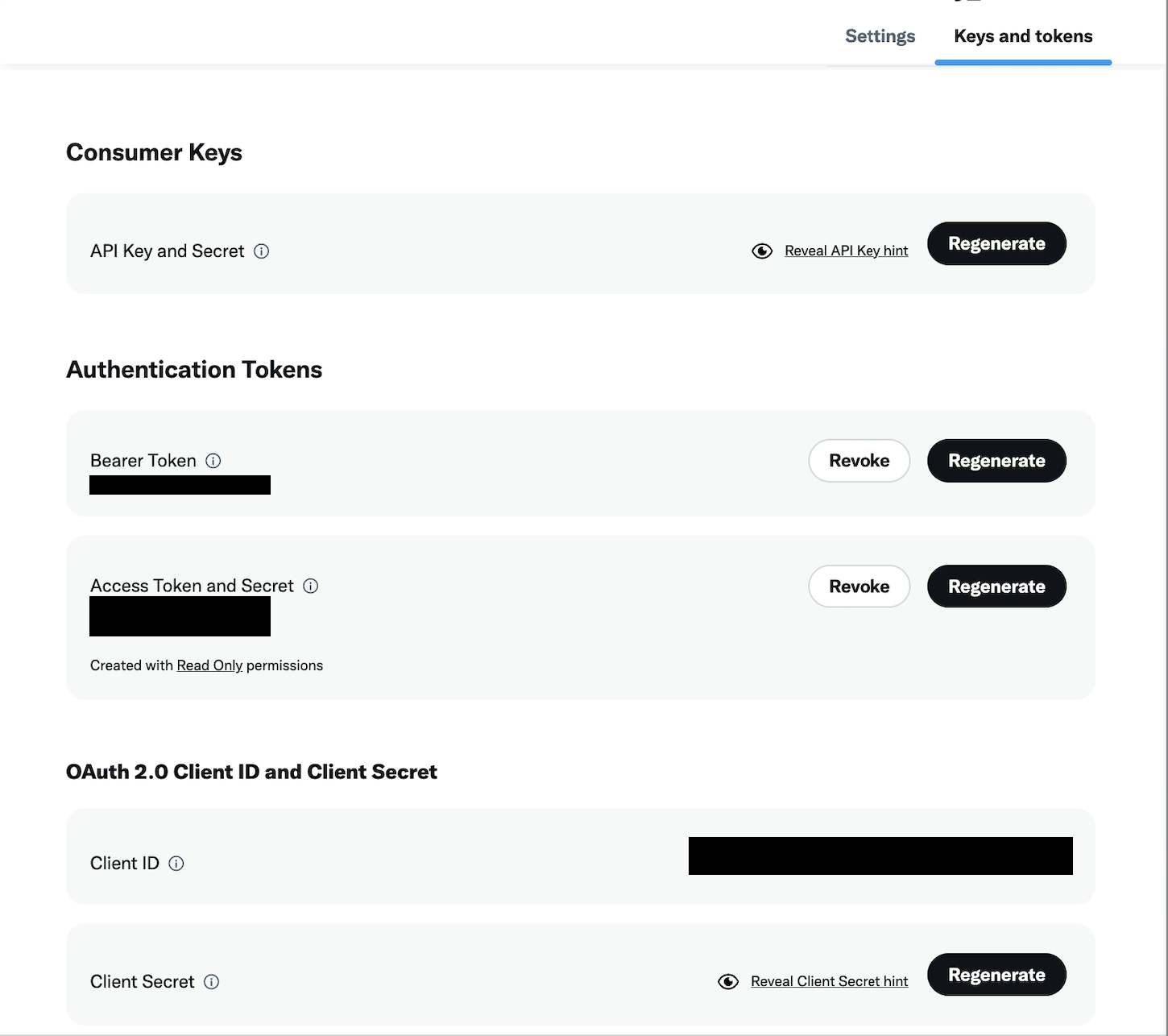
Required Scopes
In order for Turnkey to access the/2/users/me endpoint, the following scopes must be set during Authorization:
tweet.readuser.read
Setting Up Discord
Navigate to the Discord developer portal and create/setup your app. In the General Information section, you’ll need to save your Client ID and Client Secret so that these values can be uploaded to Turnkey’s servers: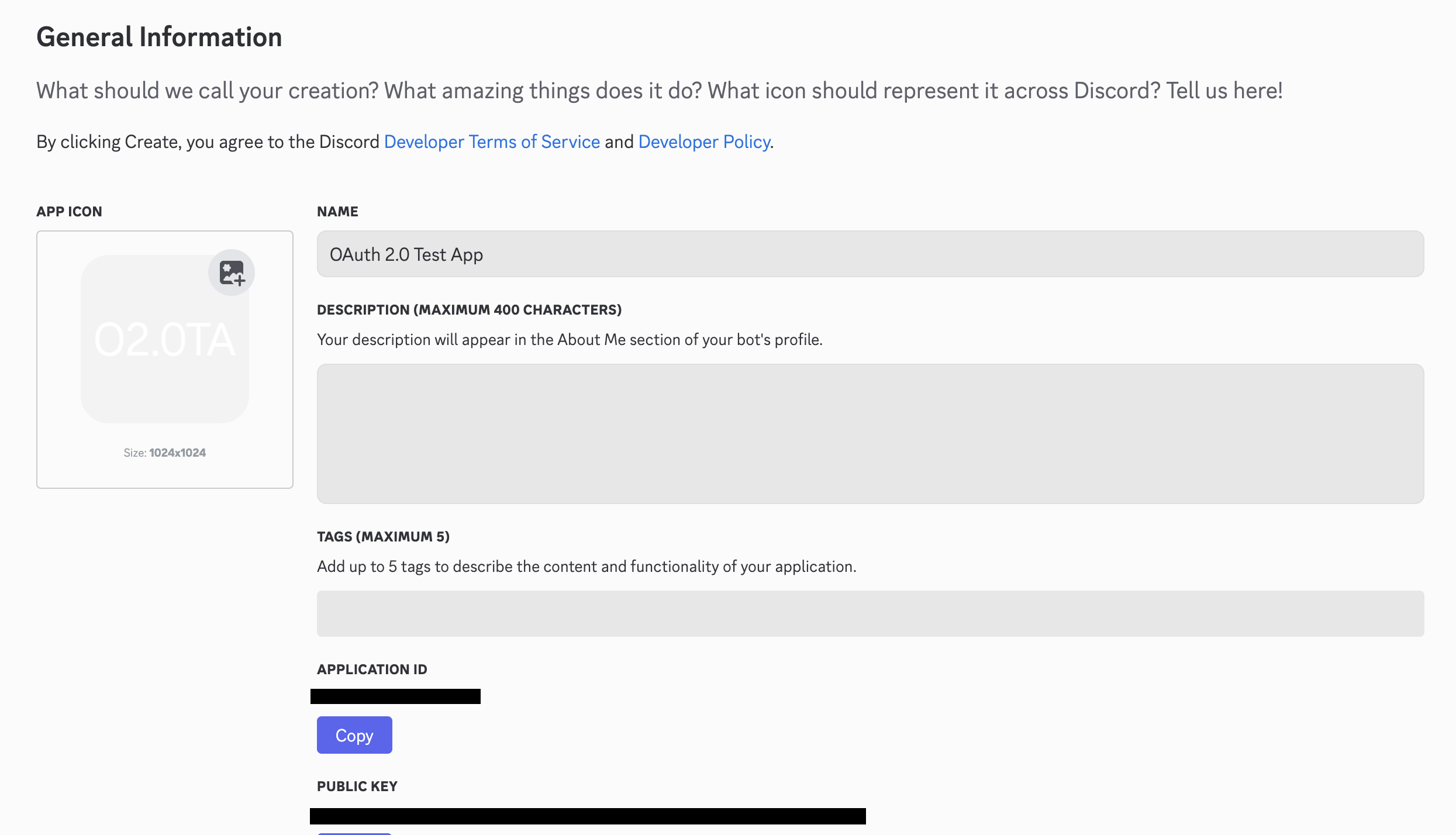
Required Scopes
In order for Turnkey to access the/api/users/@me endpoint, the following scopes must be set during Authorization:
identifyemail
Client Secret Upload
For every OAuth 2.0-Only Social Provider that you wish to integrate with, you must upload the Client ID and Client Secret issued by that Provider to Turnkey’s Servers. In order to protect these sensitive credentials, they will be encrypted to the Quorum Key of the TLS Fetcher enclave, which ensures they cannot be accessed outside of that environment. You can upload these credentials through the Turnkey Dashboard. In the Wallet Kit section of the dashboard, head to the Socials tab and click Add provider.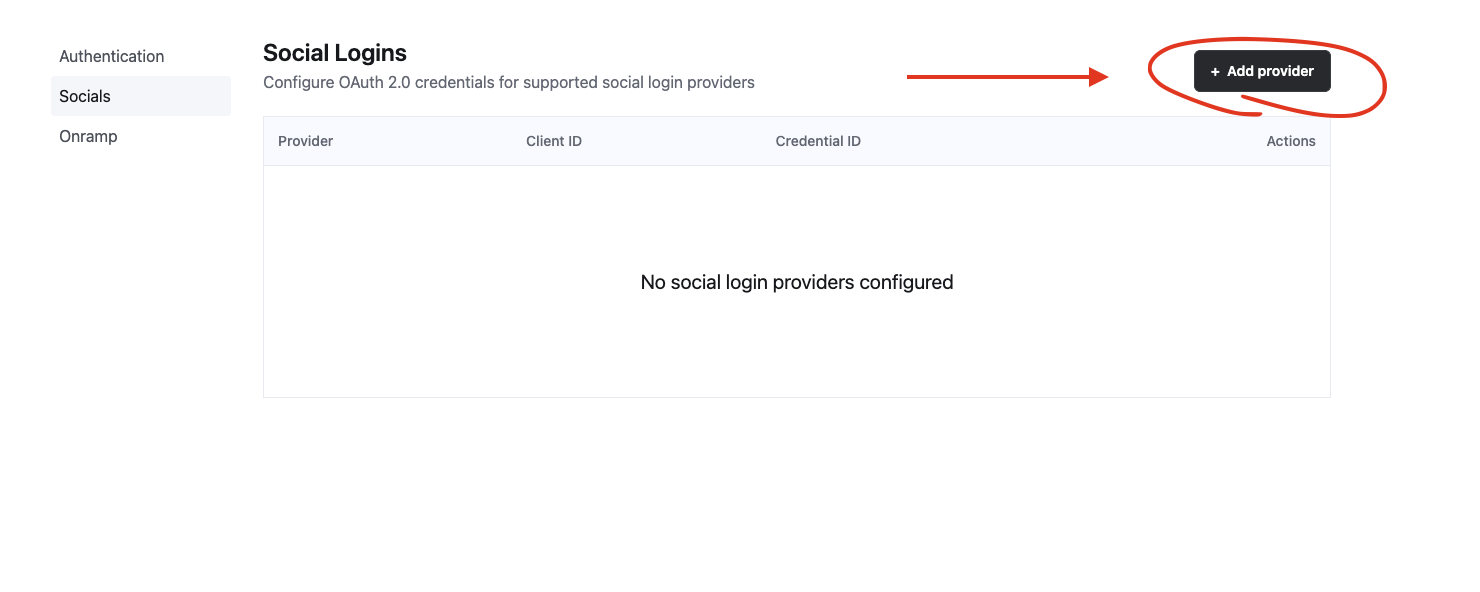
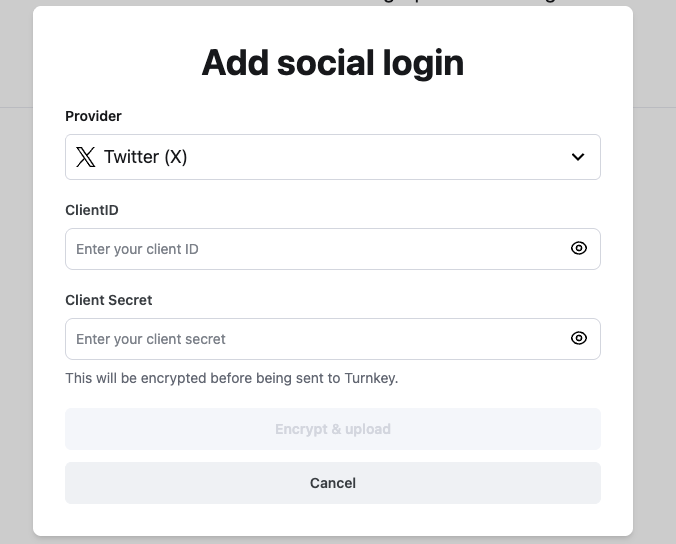
OAUTH2_AUTHENTICATE activity.

Returning the Encrypted Bearer Token
When using OAuth 2.0-Only Social Providers, it is also possible to have the bearer token returned by theOAuth2Authenticate endpoint, which can be useful if you would like your app to have additional integrations involving this Social Provider.
In order to guaruntee the secure transfer of the bearer token, it must be encrypted to a P256 Encryption Key inside our secure enclave, returned to the caller, and then finally decrypted.
Therefore, the return of the encrypted bearer token is dependent on the caller providing an optional bearerTokenTargetPublicKey parameter in the request to OAuth2Authenticate.
An example demonstrating this flow can be seen here.